Gray Earth with Shaded Relief, Hypsography, Ocean Bottom, and Drainages
Posted in 10m-gray-earth on November 4th, 2012 by Nathaniel – Comments Off on Gray Earth with Shaded Relief, Hypsography, Ocean Bottom, and Drainages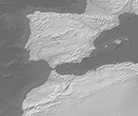

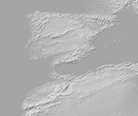
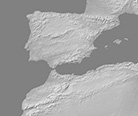
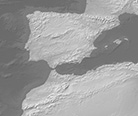
Natural Earth has been downloaded more than 250,000 times and is closing in on 1 million page views since launching in the final month of 2009. Thanks!
Over 65 files have changed in version 1.4 of Natural Earth. The most significant edits reflect the July 2011 independence of South Sudan. That country’s administrative level-1 units have also been refreshed, and the disputed area of Abyei is retained.
Mea culpa: A major correction fixes a coding error introduced in version 1.3 that incorrectly merged Panama and Papua New Guinea into a super country in some admin-0 files. Version 1.4 reestablishes them as separate countries.
Because of South Sudan, the admin-0 (sovereign, country, map units, map subunits, scale ranks, scale ranks with minor islands), boundary lines land, disputed areas and boundaries, etc. have all been updated in the 10m, 50m, 110m scale sets.
50m admin-1 states and provinces now includes a version with the lakes punched out, like the 10m has enjoyed since version 1.3.
The 10m admin-1 file now includes a “scale rank” exploded version that will import into a wider range of GIS and CAD software packages that cannot import polygons over a certain vertex count.
Other changes and corrections are detailed below and credited to the correction request author.
Nathaniel Vaughn Kelso and Tom Patterson 19 August 2011
When Natural Earth relaunched in December 2009 with updated raster and new vector data our aim was two fold: First, to give cartographers an off-the-shelf solution for creating small-scale world, regional and country maps from scratch. Second, we included a wealth of features both large and small in hopes of improving the overall geographic literacy of map readers. Since then, we’ve taken Natural Earth on an around-the-world road show and January 2011 saw our 150,000th direct download and 500,000th pageview. We even made it into Wikipedia, were featured in PrettyMaps, and power some of the goodness behind Google Fusion Tables. With today’s 1.3 release, we add a couple newly independent countries, better delineate the world’s states and provinces, and make a whole host of corrections and additions to the original dataset, detailed below. Please continue to use these fine map ingredients to make great web and print geo mashups. Bon appetit.
Nathaniel Vaughn Kelso and Tom Patterson
Raster downloads are still á la carte for 10m and 50m resolutions.
GENERAL
Files continue to be published in GIS industry standard .shp shapefiles and .tif geotiff imagery in WGS84 “geographic” projection.
By the numbers: Almost 10 new files or packages have been introduced in this release. If specific descriptions are not provided below, you may assume version 1.3 edits relate to topology and extent (vector) or georeferencing (raster) and not content. That said, the majority of files (171 out of 197) have changed with minor to large edits in version 1.3. The version is indicated on each download page. More than three-quarters of the initial 1.0 files have changed collectively in this and the prior two updates. If a file has not changed, it retains it’s earlier version number.
A new Natural Earth quick start kit (158 mb) has been added to provided a small sample of the Natural Earth themes styled in an ArcMap .MXD document (read more at the Esri Mapping Center soon) and in a QGIS document.
OSGeo Live DVD now includes small sample of Natural Earth themes for use with open source GIS software like QGIS.
RASTER
Four new cross-blended hypsometric tints resolutions now offer merged ocean bottom data and hypsometric tints without relief shading to better allow you to mashup your own.
All TIFs are now GeoTIFs with projection and cell size, registration points baked in. Readme files have been added to all. A few files that had .tfw.txt are now just .tfw. A few corrupt header files have been fixed. The corrected files were silently updated a month or so ago.
VECTOR
Many but not all features at 10m scale have been clipped to ±180, ±90 bounding box. Some themes have also had their geometry repaired to make them easier to geoprocess and reproject. The goal is to make it easier to use Natural Earth in open source software that until those app’s import horizon expands.
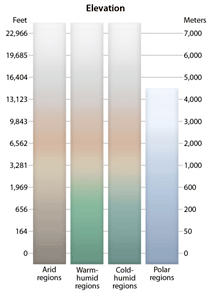 Due to popular demand, a new version of the Cross Blended Hypsometric Tints is available without relief shading. This allows the image to be used at scales other than 1:10M. The cartographer can then mix in their own scale appropriate relief shading.
Due to popular demand, a new version of the Cross Blended Hypsometric Tints is available without relief shading. This allows the image to be used at scales other than 1:10M. The cartographer can then mix in their own scale appropriate relief shading.
Background: Cross-blended Hypsometric Tints offer a partial solution to a long-standing map reading problem: many people misidentify hypsometric tints (elevation colors) as vegetation or climate regions. Conventional hypsometric tints often show green in the lowlands, yellow in mid elevations, and red in the highlands. These map colors incorrectly suggest to the untutored that forests cover the parched Persian Gulf region and a hot desert climate prevails on the Greenland ice cap.
Cross-blended hypsometric tints instead use modified elevation colors for regions that people presumably associate with the natural environment. The Sahara is dusty brown, northern Russia is boreal forest green, the Mekong delta is jungle green, and Antarctica is icy blue-grey. As in nature, the map colors gradually blend into one another across regions (x and y axis) and from lowlands to highlands (z axis), hence the name cross-blended hypsometric tints. The legend above shows the map colors modulated by elevation and environment.
This update introduces supplementary hydrography features in North America and Europe that quadruple (4x) the number of lakes and rivers there. Many thanks to Tom P. for generalizing the vectors and Preston M. for adding tapering to North America (absent in Europe). In some cases the basic 10m rivers and lakes were modified to fit the new information and that’s been refreshed, as well. The North America data comes from the CEC North America Environmental Atlas. The Europe data extract is kindly provided into the public domain by the European Commission, Joint Research Centre (JRC), thanks Alfred J! Check out their original, higher resolution Europe data.
On the cultural front, North America gets roads and rails. General 10m detail roads and railroads come from the CEC North America Environmental Atlas. The supplementary roads are donated by XNR Productions and are at 1m scale, thanks Laura M. and Rob!
If you have data or time to contribute, especially to flesh out the new transportation and hydro themes, please contact me at nathaniel@naturalearthdata.com.
Note: We are not committing to building out supplementary level of detail in the rest of the world (we’re not THAT crazy!), but will incorporate such data if you contribute it. As always, we edit these data files but you should too before you publish maps using them. Feed us back corrections.
(below) Rivers and lakes in North America. On the left the version 1.1 hydro features. On the right in color are the new, supplemental version 1.2 hydro features, 4x the density of features at the same 10m linework generalization.
(below) Rivers and lakes in Europe. On the left the version 1.1 hydro features. On the right in color are the new, supplemental version 1.2 hydro features, 4x the density of features at the same 10m linework generalization.
(below) Highways (red and blue) and ferry routes in North America.
(below) Supplemental road detail in North America. Slightly different feature class scheme and data vintage.
(below) Railroads in North America.
The download manager will be updated the next couple weeks. In the meantime, please check out the ZIP, linked below, to get the 61 changed GIS shapefiles (SHP). Release notes follow.
NOTE: Version 1.1.1 corrects the name of the 50m cultural “50m_admin_0_countries” file by adding the missing “r” (XQHSANQW71), updated March 15, 2010. Thanks Ben!
Thanks to over 50 contributors for making version 1.1 happen!
Tom, Dick, Craig, Jill, Landon, Preston, Nancy, Alfred, Brett, Annemarie, Hans, Martin, Kristin, Gene, Laris, Donatas, Kevin, Kurt, Tom, Xan, Bill, Ed, Uffe, Jochen, Christopher, Carlos, Barry, Alex, Victor, Kimi, Steve, daan, Maxb, Matt, Eugene, Damien, mizDannasag, Zoonseovasupem, Chris, Bjørn, Prof. Ward, Michael, Roy, Daniel, Kim, Gustav, Uwe, Geoff, Kumiko, Robert, Mike, Hugo, and Leo.
If you have a few hours to help, please check out the TODO listings below and email me at nathaniel@naturalearthdata.com.
Visitors: 123,000 page views since we launched in early December, 2009. Over 30,000 visits (20,000 unique) from 157 ISO countries, or 4.25 pages per visit. 65 percent are new visits. Visitors spend an average of 3 minutes 51 seconds on the site with a bounce rate less than 50 percent. Source: Google Analytics.
Downloads: 34,000. Three out of 4 downloads is ala cart, except for 10m cultural which is 1 out of every 2. Three out of every 4 downloads is for the 10m, with the rest split between 50m and the 110m. Just less than 1 out of every 2 downloads is for the raster. Source: Download Manager.
CHANGE LOG THIS RELEASE:
Overall
More than 50% changes
Less than 5% changes
TODO, spring 2010:
TODO NEXT, fall 2010:
Other
After the jump, full listing of changes.
We’re now using stronger spam checks in the forum registration area (required to post in the forums) to combat a rise in spam users. Let us know if you’re not able to get thru or your posts aren’t showing up. How do you tell if you’re posts aren’t showing up? If no one responds (you’re auto emailed when someone replies to your forum topic) -OR- if you logout and try viewing the forum as a guest user and don’t see your post.